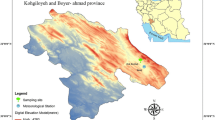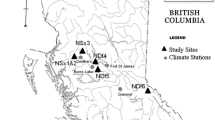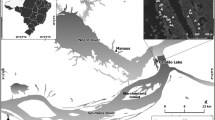Key message
The oak species Q. crassifolia produces reliable annual rings with better climatic sensitivity than many conifer species commonly used for hydroclimatic reconstructions in Mexico.
Abstract
Most dendrochronological research in Mexico has been done with conifers, but broadleaf species have been underutilized. Mexican oaks are found among those species receiving limited attention for dendrochronological purposes, despite Mexico being a primary center of oak diversity with over 160 species. The objectives of this study were: (1) date the annual radial increments of oaks (Quercus crassifolia Bonpl.), and (2) analyze the dendrochronological potential and climatic response of the species to reconstruct historical climatic variability and the influence of ocean–atmospheric modes. The study was located at the Barajas site, municipality of Tepehuanes, Durango, Mexico. Wood samples consisted of 60 cross sections, 30 of them obtained at the base of the stem, and 30 more ca. 20–30 cm above the first cross section, which were analyzed by dendrochronological techniques. A tree-ring width chronology 177 years long (1840–2016) was developed indicating suitable values of series intercorrelation (0.52), mean sensitivity (0.26), signal-to-noise ratio (8.98), first-order autocorrelation (0.21), rbar (0.28), and expressed population signal (0.86) for the period 1890–2016. Dendrochronological parameters were similar or superior to those obtained from conifer species in the region. The chronology shows the strongest relationship with October–May precipitation, explaining ca. 60% of its variability (1951–1984, r = 0.78, p < 0.01), but a negative response to the average seasonal October–May temperature (1902–2016, r = -0.50, p < 0.01). The annual growth rings of Q. crassifolia showed a negative association (1890–1977, r = – 0.67, p < 0.01) with the El Niño-Southern Oscillation (reconstructed Southern Oscillation Index), and positive with the Pacific Decadal Oscillation Index (1948–2015, r = 0.39, p < 0.01, the reconstructed Palmer Drought Severity Index (1890–2012, r = 0.73, p < 0.01), and the seasonal winter–spring Standard Precipitation Index (1890–2016, r = 0.76, p < 0.01).








Similar content being viewed by others
References
Acosta-Hernández AC, Pompa-García M, Camarero J (2017) An updated review of dendrochronological investigations in Mexico, a megadiverse country with a high potential for tree-ring sciences. Forests 8:160. https://doi.org/10.33900/f8050160
Allan RJ, Lindesay L, Parker DE (1996) El Niño/Southern Oscillation and climate variability. CSIRO Publishing, Atmospheric Research, Australian National University, United Kingdom, Meteorological Office, pp. 408
Bartens J, Grissino-Mayer HD, Day SD, Wiseman PE (2012) Evaluating the potential for dendrochronological analysis of live oak (Quercus virginiana Mill.) from the urban and rural environment- an exploratory study. Dendrocronologia 30:15–21. https://doi.org/10.1016/j.dendro.2011.04.002
Biondi F, Waikul K (2004) Dendroclim2002: A C + + program for statistical calibration of climate signals in tree-ring chronologies. Comput Geosci 30:303–311. https://doi.org/10.1016/j.cageo.2003.11.004
Briffa K, Jones PD (1990) Basic chronology statistics and assessment. In: Cook E, Kairiusktis L (eds) Methods of dendrochronology: applications in the environmental sciences. Springer-Science, Dordrecht, pp 137–152
Bunn AG (2008) A dendrochronology program library in r (dplr). Dendrochronologia 26:115–124. DOI:https://doi.org/10.1016/j.dendro.2008.01.002
Castruita-Esparza LU, Silva LCR, Gómez-Guerrero A, Villanueva-Díaz J, Correa-Díaz A, Horwath WR (2019) Coping with extreme events: growth and water-use efficiency of trees in western Mexico during the driest and wettest periods of the past one hundred sixty years. J Geophys Res Biogeosci. https://doi.org/10.1029/2019JG005294
Challenger A (1998) Utilización y conservación de los ecosistemas terrestres de México, pasado, presente y futuro [Use and conservation of the terrestrial ecosystems of Mexico, past, present and future]. In: Comisión Nacional para el Conocimiento y Uso de la Biodiversidad. CONABIO, México, p 847
Cleaveland MK, Stahle DW, Therrell MD, Villanueva-Diaz J, Burns BT (2003) Tree-ring reconstructed precipitation and tropical teleconnections in Durango, Mexico. Clim Change 59:369–388. https://doi.org/10.1023/A:1024835630188
Constante García V (2015) Aplicación de técnicas dendrocronológicas en Pinus pseudostrobus Lindl y Quercus cambeyi Trel. para analizar la influencia climática y el cambio de uso del suelo. Tesis de maestría [Applications of dendrochronological techniques in Pinus pseudostrobus Lindl and Quercus cambeyi Trel. to analyze the climatic influence and the change of land use. Master Degree Thesis]. Universidad Autónoma de Nuevo León. Facultad. Linares, N.L., pp. 110
Constante V, Villanueva J, Pérez E, Martínez A (2017) Características anatómicas y potencial dendrocronológico de algunas especies de encino (Quercus sp.) en el norte de México [Anatomical characteristics and dendrochronological potential of some oak species (Quercus sp.) in northern Mexico]. Folleto Técnico No. 43. ISBN: 978-607-37-0833-3. INIFAP CENID RASPA. Gómez palacio, Durango, pp. 39
Cook EW (1985) A time series approach to tree-ring standardization. PhD Dissertation. University of Arizona, Tucson, AZ, USA
Cook EW (1987) The decomposition of tree-ring series for environmental studies. Tree-Ring Bull 43:37–59. https://repository.arizona.edu/bitstream/handle/10150/261788/trb-47-037-059.pdf?sequence=1
Cook EW, Meko DM, Stahle DW, Cleaveland MK (1999) Drought reconstructions for the Continental United States. J Clim 12:1145–1162. https://doi.org/10.1175/1520-0442(1999)012>1143:DRFTCU>2.0.CO;2
Cortés-Sánchez BG, Ángeles-Pérez G, De los Santos-Posadas HM, Ramírez-Maldonado H (2019) Allometric equations to estimate biomass in oak species in Guanajuato, Mexico. Madera y Bosques 25(2):e2521799. doi:https://doi.org/10.21829/myb.2019.2521799
Cruz-Huerta C, González-Guillén MJ, Martínez-Trinidad T, Escalona-Maurice M (2017) Identifying priority conservation areas for above-ground carbon sequestration in Central Mexico. iForest 10:923–929. doi:https://doi.org/10.3832/ifor1980-010 [online 2017-12-07]
De la Paz Pérez-Olvera C, Dávalos-Sotelo R, Guerrero-Cuacuil E (2000) Aprovechamiento de encino en México [Use of oak Wood in Mexico]. Madera y Bosques 6(1):3–13. https://doi.org/10.21829/myb.2000.611338
De la Pérez-Olvera P, Dávalos-Sotelo CR (2008) Algunas características anatómicas y tecnológicas de la madera de 24 especies de Quercus (encinos) de México [Some anatomical ans technological features of 24 oak (Quercus) species of Mexico]. Madera y Bosques 14(3):43–80
Diaz SC, Therrell MD, Stahle DW, Cleaveland MK (2002) Chihuahua (Mexico) winter-spring precipitation reconstructed from tree-rings, 1647–1992. Clim Res 22:237–244. https://doi.org/10.3354/cr022237
Douglas MW, Maddox RA, Howard K, Reyes S (1993) The Mexican monsoon. Am Meteorol Soc 6:1665–1677. https://doi.org/10.1175/1520-0442(1993)006<1665:TMM>2.0.CO;2
ERIC III Versión 3.2 (2013) Extractor rápido de información climatológica [Fast extractor of climatological information]. Instituto Mexicano de Tecnología del Agua. CONAGUA. Jiutepec, Morelos
Fried MA, Sulla-Menashe D (2019) MCD12Q1 MODIS/Terra + Aqua Land cover Type Yearly L3 Global 500 m SIN Grid V006. NASA EOSDIS Land Processes DAAC. https://doi.org/10.5067/MODIS/MCD12Q1.006
Fritts HC (1976) Tree rings and climate. Academic Press. London, New York, pp. 565
Fuentes-Franco R, Giorgi F, Coppola E, Kucharski F (2016) The role of ENSO and PDO in variability of winter precipitation over North America from twenty first century CMIp5 projections. Clim Dyn 46:3259–3277. DOI:https://doi.org/10.1007/S00382-015-2767.y
Galicia L, Potvin C, Messier C (2015) Maintaining the high diversity of pine and oak species in Mexican temperate forests: a new management approach combining functional zoning and ecosystem adaptability. Can J For Res 45(10):1358–1368. https://doi.org/10.1139/cjfr-2014-0561
García-Molina JG (2008) carbono de Encino: fuente de calor y energía [oak charcoal: source of heat and energy]. CONABIO Biodivers 77:7–9
González-Elizondo M, Jurado E, Navar J, González-Elizondo MS, Villanueva J, Aguirre O, Jiménez J (2005) Tree-rings and climate relationships for Douglas-fir chronologies from the Sierra Madre Occidental, Mexico: A 1681–2001 rain reconstruction. For Ecol Manage 213:39–53
González-Elizondo MS, González-Elizondo M, Márquez-Linares MA (2007) Vegetación y ecoregiones de Durango [Vegetation and ecoregions of Durango]. Plaza y Valdés Editores. Durango, pp. 219
Gorgonio-Ramírez M, Clark-Tapia R, Campos JE, Monsalvo-Reyes A, Alfonso-Corrado C (2017) Diversidad y estructura genética de Quercus crassifolia en sitios de manejo forestal y uso local en Sierra de Juárez, Oaxaca [Diversity and genetic structure of Quercus crassifolia in forest management sites and local use in Sierra de Juarez, Oaxaca]. Madera y Bosques 23(2):85–98. https://doi.org/10.21829/myb.2017.2321122
Grissino-Mayer HD (2001) Evaluating crossdating accuracy: a manual and tuitorial for the computer program COFECHA. Tree-Ring Res 57(2):205–221
Gutzler DS (2004) An index of interannual precipitation variability in the core of the North American Monsoon Region. J Clim 17:4473–4480
Harris I, Osborn TJ, Jones P, Lister D (2020) Version 4 of the CRU TS monthly high-resolution gridded multivariate climate dataset. Sci Data 7:109. https://doi.org/10.1038/s41597-020-0453-3
Holmes RL (1983) Computer-assisted quality control in tree-ring dating and measurement. Tree-Ring Bulletin 43:69–78. https://repository.arizona.edu/handle/10150/261223
IAWA COMMITTEE (1989) IAWA list of microscopic features for hardwood identification. IAWA Bulletin 10:219–332
INEGI (2012) Carta nacional de uso del suelo y vegetación [National cartography of land use and vegetation]. Aguascalientes, México
Irby CM, Fulé PZ, Yocom LL, Villanueva-Diaz J (2013) Dendrochronological reconstruction of long-term precipitation in Basaseachi National Park, Chihuahua, Mexico. Madera y Bosques 19(1):93–105
Magaña VO, Vázquez JL, Pérez JL, Pérez JB (2003) Impact of El Niño on precipitation in Mexico. Geofísica Internacional 42(3):313–330
Manos PS, Doyle JJ, Nixon KC (1999) Phylogeny, biogeography, and processes of molecular differentiation in Quercus subgenus Quercus (Fagaceae). Mol Phylogenet Evol 12:333–349. https://doi.org/10.1006/mpev.1999.0614
Mantua NJ, Hare SR, Zhang Y, Wallace JM, Francis RC (1997) A Pacific interdecadal climate oscillation with impacts on salmon production. J Clim 78(6):1069–1079. https://doi.org/10.1175/1520-0477(1997)078<1069:APICOW>2.0.CO;2
Martínez-Cruz J, Téllez-Valdéz O, Ibarra-Manríquez G (2009) Oak forest structure in the Sierra de Santa Rosa range, Guanajuato, Mexico. Revista Mexicana de Biodiversidad 80:145–156
Martínez-Sifuentes AR, Villanueva-Díaz J, Estrada-Ávalos J (2020) Runoff reconstruction and climatic influence with tree rings, in the Mayo River Basin, Sonora. Mexico iForest 13:98–106. https://doi.org/10.3832/ifor3190-013
McCarthy GD, Haigh ID, Hirschi JJM, Grist JP, Smeed DA (2015) Ocean impact on decadal Atlantic climate variability revealed by sea-level observations. Nature 521:508–510. https://doi.org/10.1038/nature14491
Meko DM, Touchan R, Villanueva-Diaz J, Griffin D, Woodhouse CA, Castro CL, Leavitt SW (2013) Sierra San Pedro Martir, Baja California cool-season precipitation reconstructed from earlywood width of Abies concolor tree rings. J Geophys Res Biogeosci 118:1660–1673. https://doi.org/10.1002/2013JG002408
Mendez M, Magaña V (2010) Regional aspects of prolonged meteorological droughts over Mexico and Central America. J Clim 23:1175–1188. https://doi.org/10.1175/2009JCLI3080.1
Navar-Chaidez J (2010) Biomass allometric for tree species of northwestern Mexico. Tropical Subtropical Agroecosystems 12:507–519
Palmer WC (1965) Meteorological Drought. Research paper No. 45, U.S. Department of Commerce Weather Bureau, pp. 58
Pavia EG, Graef F, Reyes J (2006) PDO–ENSO effects in the climate of Mexico. J Clim 19(24):6433–6438. https://doi.org/10.1175/JCLI4045.1
Quiñonez-Barraza G, Zhao D, De los Santos-Posadas HM, Santiago-García W, Tamarit-Urías JC, Nájera-Luna J (2019) Compatible taper, volume, green weight, biomass and carbon concentration system for Quercus sideroxyla Bonpl. Rev Chapingo Ser Ciencias For Ambiente 25(1):49–69. https://doi.org/10.5154/r.rchscfa.2018.06.050
Quintanar J (2002) Características, propiedades y procesos de transformación de la madera de encinos en México [Characteristics, properties, and transformation processes of poak wood in Mexico]. San Martinito, Puebla, México, INIFAP CIRCE, C.E
R Core Team (2013) R: A language and environment for statistical computing. R Foundation for Statistical Computing, Vienna, Austria. URL http://www.R-project.org/
Rodríguez-Larramendi LA, Guevara-Hernández F, Reyes-Muro L, Ovando-Cruz J, Nahed-Toral J, Prado-López M, Campos Saldaña RA (2016) Estimación de biomasa y carbono almacenado en bosques comunitarios de la región Frailesca de Chiapas, México. Rev Mexicana Ciencias For 7(37):77–94
Ruiz-Aquino F, Valdéz-Hernández J, Manzano-Méndez F, Rodríguez-Ortíz G, Romero-Manzanares A, Fuentes-López M (2014) Ecuaciones de biomasa aérea para Quercus laurina y Quercus crassifolia en Oaxaca [Air biomass equations for Quercus laurina and Q. crassifolia in Oaxaca]. Madera y Bosques 20(2):33–48. https://doi.org/10.21829/myb.2014.202162
Ruiz-Aquino F, González-Peña MM, Valdéz-Hernández JI, Romero-Manzanares A (2016) Estructura anatómica de la madera de dos especies de encinos en Oaxaca [Anatomical structure of two species of oak wood in Oaxaca]. Madera y Bosques 22(1):177–189. https://doi.org/10.21829/myb.2016.221485
Rzedowski J (1981).Vegetación de México [Vegetation of Mexico]. LIMUSA. México, D.F
Schweingruber FH (1993) Trees and wood in dendrochronology: morphological, anatomical, and tree-ring analytical characteristics of trees frequently used in dendrochronology. Springer-Verlag, Berlin
Scareli-Santos C, Sánchez-Mondragón ML, González-Rodríguez A, Oyama K (2013) Foliar micromorphology of Mexican oaks (Quercus: Fagacea). Acta Bot Mex 104:31–52
Schweingruber FH (1996) Tree rings and environment. Dendroecology. Birmensdorf, Swiss Federal Institute for Forest, Snow and Landscape Research. Berne, Stuttgart, 609 pp
Speer J (2010) Fundamentals of tree-ring research. University of Arizona Press, Tucson, p 509
Stahle DW, Hehr JG (1984) Dendroclimatic relationships of post oak across a precipitation gradient in the southcentral United States. Ann Assoc Am Geogr 74(4):561–573. https://doi.org/10.1111/j.1467-8306.1984.tb01474.x
Stahle DW, D’Arrigo RD, Krusic PJ, Cleaveland MK, Cook ER, Allan RJ, Cole JE, Dunbar RB, Therrell MD, Guy DA, Moore MD, Stokes MA, Burns BT, Villanueva-Diaz J, Thompson LG (1998) Experimental dendroclimatic reconstruction of the Southern Oscillation. Bull Am Meteorol Soc 70(10):2137–2152
Stahle DW (1999) Useful strategies for development of tropical tree-ring chronologies. IAWA J 20(3):249–253
Stahle DW, Villanueva-Diaz J, Cleaveland MK, Therrell MD, Paull G, Burns B, Salinas W, Suzan H, Fule PZ (2000) Recent tree-ring research in Mexico. In: En FA, Roig (eds) Dendrocronología en América Latina. EDIUNC, Mendoza, pp 285–306
Stahle DW, Burnette DJ, Villanueva-Diaz J, Heim RR, Fye FK, Cerano-Paredes J, Acuña-Soto R, Cleaveland MK (2011a) Pacific and Atlantic influences in Mesoamerican over the past millennium. Clim Dyn 39:1431–1446. https://doi.org/10.1007/s00382-011-1205-z
Stahle DW, Griffin RD, Cleaveland MK, Edmondson JR, Fye FK, Burnette DJ, Abatzoglon JT, Redmond KT, Meko DM, Dettinger MD, Cayan D, Therrell MD (2011b) A tree-ring reconstruction of the salinity gradient in the northern estuary of San Francisco Bay. San Francisco Estuary Watersh Sci 9(1):1–22. https://doi.org/10.15447/sfews.2011v9iss1art4
Stahle DW, Cook ER, Burnette DJ, Villanueva J, Cerano J, Burns JN, Griffin D, Cook B, Acuña R, Torbenson MCA, Sjezner P, Howard J (2016) The Mexican drought atlas: tree-ring reconstructions of the soil moisture balance during the late pre-Hispanic, colonial, and modern eras. Quatern Sci Rev 149:34–60. https://doi.org/10.1016/j.quascirev.2016.06.018
Stahle DW, Cook ER, Burnette DJ, Torbenson CMA, Howard IM, Griffin D, Villanueva-Diaz J, Cook BI, Williams AP, Watson E, Sauchyn DJ, Pederson N, Woodhouse CA, Pederson GT, Meko D, Coulthard B, Crawford CJ (2020) Dynamics, variability, and change in seasonal precipitation reconstructions for North America. J Clim 33(4):3173–3195. doi:https://doi.org/10.1175/JCLI-D-19-0270.1
Steel G, Torrie J (1980) Principles and procedures of statistics, 2nd edn. McGraw-Hill, New York, p 633
Stokes MA, Smiley MD (1968) An introduction to tree-ring dating. The University of Arizona Press, Tucson
Terán A (2010) Escenarios de lluvia en México. Disertación [Rainfall scenarios in Mexico. Dissertation]. CIEMAD-IPN. México, D.F
Therrell MD (2003) Tree rings, climate and history in Mexico. Dissertation. Environmental dynamics, Department of Geosciences, University of Arkandsas. Fayetteville, AR
Torbenson MCA, Stahle DW, Howard IM, Burnette DJ, Villanueva-Díaz J, Cook ER, Griffin D (2019) Multidecadal modulation of the ENSO teleconnection to precipitation and tree growth over subtropical North America. Paleoceanogr Paleoclimatol 34:886–900. https://doi.org/10.1029/2018PA003510
Valencia S (2004) Diversidad del género Quercus (Fagaceae) en México [Diversity of the genus Quercus (Fagaceae) in Mexico]. Bol Soc Bot Méx 75:33–53. https://doi.org/10.17129/botsci.1692
Vargas-Larreta B, López-Sánchez C, Aguirre-Calderón C, Álvarez-González J (2017) Allometric equations for estimating biomass and carbon stocks in the temperate forests of north-western Mexico. Forests 8(269) 10-3390/f8080269
Villanueva-Diaz J, Stahle DW, Cleaveland MK, Therrell MD (2000) Estado actual de la dencrocronología en México [Current state of dendrochronology in Mexico]. Cienc For 25:5–36
Villanueva-Diaz J, Luckman BH, Stahle DW, Therrell MD, Cleaveland MK, Cerano-Paredes J, Gutierrez-Garcia G, Estrada-Avalos J, Jasso-Ibarra R (2005) Hydroclimatic variability of the upper Nazas basin: water management implications for the irrigated area of the Comarca Lagunera. Dendrochronologia 22(3):215–223. https://doi.org/10.1016/j.dendro.2005.04.005
Villanueva-Diaz J, Cerano-Paredes J, Stahle DW, Constante-García V, Vázquez-Selem L, Estrada-Ávalos J, De Dios-Benavides J (2010) Árboles longevos de México [Mexican old trees]. Rev Mex Cienc For 1(2):1–23
Villanueva-Diaz J, Cerano-Paredes J, Stahle DW, Luckman BH, Therrell MD, Cleaveland MK, Fulé PZ (2011) La dendrocronología y reconstrucciones paleoclimáticas en el norte-centro de México [The dendrochronology an paleoclimatic reconstructions in the north-center of Mexico]. In: M. Caballero, B. Ortega G. (Compiladoras), Escenarios de cambio climático: Registros del Cuaternario en América Latina I [Climatic change scenarios: Quaternary records in Latin America]. UNAM, Instituto de Geofísica, Dirección General de Publicaciones y Fomento Editorial. México, D.F., pp. 408
Villanueva-Diaz J, Cerano-Paredes J, Rosales-Mata S, Arrocena J, Stahle DW, Ruiz-Castro JA, Martínez-Sifuentes AR (2014) Variabilidad hidroclimática reconstruida con anillos de árboles para la cuenca alta del Río Mezquital, Durango [Reconstructed hydroclimatic variability with tree rings for the upper Rio Mezquital, Durango watershed]. Revista Mexicana de Ciencias Agrícolas. Pub. Esp. 10: 1897–1912
Villanueva-Diaz J, Gómez-Guerrero A, Cerano-Paredes J, Rosales-Mata S, Estrada-Ávalos J, Castruita-Esparza L, Martínez-Sifuentes AR (2017) La variabilidad del caudal del río Acaponeta inferida mediante series de anillos de crecimiento en coníferas [The variability of the streamflow in the Acaponeta river inferred by tree ring series of conifer]. Tecnología y Ciencias del Agua VIII (3): 55–74. 10.24850/j-tyca-2017-03-04
Villanueva-Díaz J, González-Elizondo M, Cerano-Paredes J, Estrada-Avalos J, Martínez-Sifuentes AR, Rosales-Mata S (2018) Red dendrocronológica de pino triste (Pinus lumholtzii B.L. Rob & Fernald) en la Sierra Madre Occidental para reconstrucción de lluvia estacional. Madera y Bosques 24(2):1–31 (e2421530)
Villaseñor JL, Ortiz E (2014) Biodiversidad de las plantas con flores (Division Magnoliopyta) en Mexico. Rev Mex Biodivers 85:134–142. https://doi.org/10.7550/rmb.31987
Wang J, Zeng N, Wang M (2016) Interannual variability of the atmosphere CO2 growth rate: roles of precipitation and temperature. Biogeosciences 13:2339–2352. (10.5194/bg-13-2339-2016)
Wigley ML, Brifa KR, Jones PD (1984) On the average value of correlated time series, with applications in dendroclimatology and hydrometeorology. J Clim Appl Meteorol 23:201–213
Wolter K (1987) The Southern Oscillation in Surface circulation and climate over the tropical Atlantic, Eastern Pacific, and Indian Oceans as captured by cluster analysis. Journal of Climate and Applied Meteorology 20: 540–558. https://doi.org/10.1175/1520-0450(1987)026<0540:TSOISC>2.0.CO;2
Wright PB (1979) Persistence of rainfall anomalies in the central Pacific. Nature 277:371–374. https://doi.org/10.1038/277371a0
Zavala CF (1995) Encinos y robles [Quercus]. Notas fitogeográficas: Universidad Autónoma de Chapingo. Texcoco, Estado de México, pp. 44
Zavala CF (2003) Identificación de encinos de México [Oak identification of Mexico]. Universidad Autónoma de Chapingo. Montecillos, Texcoco, Estado de México, pp. 1817
Zhang Y, Wallace JM, Iwasaka N (1996) Is climate variability over the North Pacific a linear response to ENSO? J Clim 9:1468–1478. https://doi.org/10.1175/1520-0442(1996)009<1468:ICVOTN>2.0.CO;2
Acknowledgements
This study was supported by two grants given to the first author “Dendrochronological studies of oak communities in northern Mexico for reconstruction of climate, biomass production, and carbon sequestration (Grant No. 1-1.6-856534886-F-M.2–3, and funded by INIFAP and by the “Dendrochronological Mexican network: hydroclimatic and ecological applications, FOINS” SEP-CONACYT CB 2016-1, No. 283134.
Author information
Authors and Affiliations
Corresponding author
Ethics declarations
Conflict of interest
The authors declare that they have no conflict of interest.
Additional information
Francisco M. Cánovas.
Publisher’s note
Springer Nature remains neutral with regard to jurisdictional claims in published maps and institutional affiliations.
Supplementary Information
Below is the link to the electronic supplementary material.
Rights and permissions
About this article
Cite this article
Villanueva-Díaz, J., Martínez-Sifuentes, A.R., Quiñonez-Barraza, G. et al. Annual radial growth and climatic response of Quercus crassifolia bonpl. in northwestern Durango, Mexico. Trees 35, 783–798 (2021). https://doi.org/10.1007/s00468-020-02077-5
Received:
Accepted:
Published:
Issue Date:
DOI: https://doi.org/10.1007/s00468-020-02077-5




